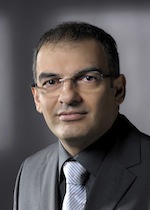AG Hashemolhosseini
AG Hashemolhosseini
Group Leader:
Prof. Dr. rer. nat. Said Hashemolhosseini
Institut für Biochemie
Lehrstuhl für Biochemie und Pathobiochemie (Prof. Dr. Wegner)
- Telefon: +49 9131 85-24634
- E-Mail: said.hashemolhosseini@fau.de
Research Focus
transduction pathways interact to regulate cell fate during embryonic
developmental, synapse formation, and adult tissue regeneration. We use a wide
combination of approaches to gain insight into how genes and the environment
interact in causation of common birth defects and muscle diseases, and how adult
stem cells are called into action to repair injury to tissues.
Skeletal muscle stem cells
Skeletal muscle stem cells are the source of skeletal muscle’s remarkable
regenerative properties. Skeletal muscle stem cells are maintained in a
quiescent state during homeostasis but upon muscle injury they activate,
proliferate, and differentiate to form new muscle. Mechanisms whereby quiescent
stem cells sense and respond to tissue damage are, however, a persistent enigma
in regenerative biology. Our recent work revealed that canonical Wnt and Hippo
signaling members are governing these processes.
Adult skeletal muscle fibers
Skeletal muscle cells are the individual contractile cells within a muscle, and
are often termed as muscle fibers. A single muscle such as the biceps in a young
adult male contains around 253,000 muscle fibers. There are about 600 muscles in
the human body. The three types of muscle fibres are slow oxidative, fast
oxidative and fast glycolytic. Our work approaches better understanding of
molecular signal path in physiology and pathophysiology (myopathies,
rhabdomyosarcoma) of skeletal muscles.
The neuromuscular junction
The three main types of muscle include skeletal, smooth and cardiac. The brain,
nerves and skeletal muscles work together to cause movement – this is
collectively known as the neuromuscular system. The contact point between nerve
ending and muscle fiber, the neuromuscular junction, is a chemical synapse
mandatory for viability by ensuring basic processes, like locomotion and
breathing. The hallmark of the postsynapse are clustered neurotransmitter
receptors. Their clustering requires action of the AGRN/LRP4/MUSK signaling. Our
projects wish to contribute to better understand of individual and concerted
roles of intracellular signaling pathways regarding neuromuscular biology in
health and disease (myasthenia).
GCMa and GCMb belong to a recently identified small transcription factor family involved in a number of fundamental processes in mammals. According to their 3D structure, GCM proteins represent a new zinc containing class of transcription factors with a conserved novel type of DNA binding domain assembled of two subdomains both rich in beta-pleated sheets. A five-stranded beta-sheet from the large domain protrudes into the major groove perpendicularly to the DNA axis. Although the prototype of GCM proteins is mainly expressed in the nervous system of Drosophila, up to now GCMa has only been identified in placenta, kidney and thymus of mammals. First, we aim to understand the biological role of GCMa in the kidney by generation and characterization of genetically altered mice. Second, we are conducting screens for identification of GCMa binding partners and GCMa target genes. Third, we are investigating molecular details of the protein kinase A mediated GCMa-Syncytin pathway. Syncytin, a fusogenic protein expressed in placental trophoblast cells, mediates the formation of placental syncytiotrophoblasts. Recently, it has been demonstrated that GCMa regulates syncytin gene expression. Since GCMa might play a role in pathological states of the placenta, like pre-ecplampsia, further knowledge of the molecular action of mammalian GCM proteins might clarify mechanistical details of its contribution to disease.


